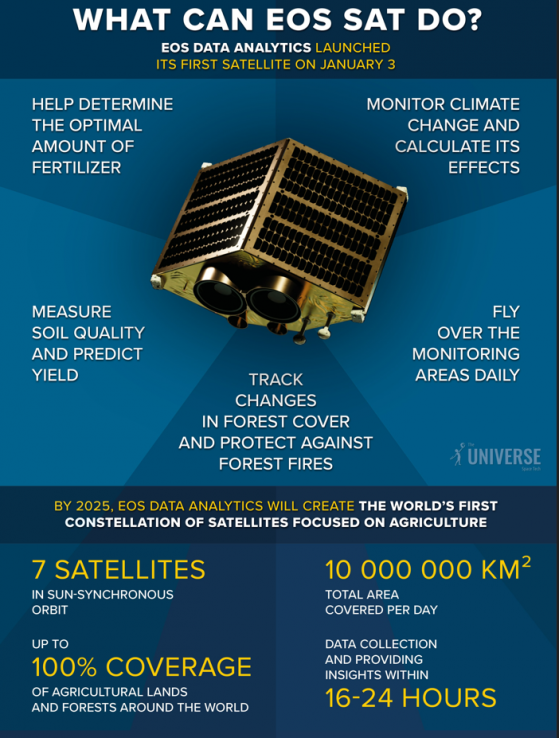EOS Data Analytics, a US-based AI-powered satellite imagery analytics outfit, has launched its first agri-focused satellite EOS SAT-1 into a low earth orbit aboard SpaceX's Falcon 9 rocket from the Cape Canaveral Space Force Station in Florida.
The satellite is the first of a constellation of seven small optical satellites, together called the EOS SAT, developed to support the implementation of sustainable agriculture methods and environmental monitoring of forestlands by providing high-quality data for analysis.
EOS SAT technology will allow farmers to diminish carbon dioxide (CO2) emissions and develop sustainable agriculture methods without financial losses.
After reaching full operation by 2025, EOS SAT will cover countries with the largest areas of farmlands and forestlands, amounting to 98.5% of such lands across the globe.
The constellation will monitor up to 12 million square kilometres daily and its satellite cameras will generate panchromatic and multispectral imagery using 13 agri-related bands to provide specific information about the required aspects of the land in question.
From increasing field productivity to reducing #CO2 emissions, ????️ #EOS_SAT will ensure you get the best possible experience. ???? Watch the video to see exactly what this #SatelliteConstellation is capable of. pic.twitter.com/4Ya5JcetdX— EOS Data Analytics (@eos_da) December 13, 2022
“Game-changing possibilities”
Congratulating the team on the launch, EOS CEO Artiom Anisimov said: “I would like to congratulate the entire team of EOS Data Analytics on the launch of EOS SAT-1.
“This launch brings new game-changing possibilities of satellite technologies to the agricultural industry.
“EOSDA will now work with proprietary datasets to provide even deeper and more accurate insights for its customers and partners,"
Current fuctionality
The first satellite in the orbit, EOS SAT-1, monitors up to one million square kilometres daily using 11 agri-related bands.
Yet even with only one such satellite in the sky, EOSDA has the potential to unlock and implement precision agriculture practices and thus reduce CO2 emissions, cut energy consumption, decrease water usage and more.
Moving forward, EOS SAT-2 and the following satellites are expected to get into orbit between 2023 and 2024.
Meanwhile, the full operational capability of the EOS SAT constellation is scheduled to be achieved in 2025.
EOS SAT functionalities.
Who is building it?
All seven satellites are being built by Dragonfly Aerospace, a space imaging systems technology provider based in South Africa.
Dragonfly CEO and co-founder Bryan Dean said: "We're excited to be the technology partner for EOS SAT, the first commercial constellation tailored specifically to agriculture needs.
“The demand for high-performance, compact and lightweight satellites keeps growing each year providing a great market for our imaging products.
“At the same time, it is great to have a customer with such a clear focus on addressing issues that are key to the sustainability of life on the planet.
“Having an agri-focused set of sensors, EOS SAT will collect the data that can actually help decision makers take care of the Earth and maintain its biodiversity while providing food security for its many people."
Read more on Proactive Investors AU
